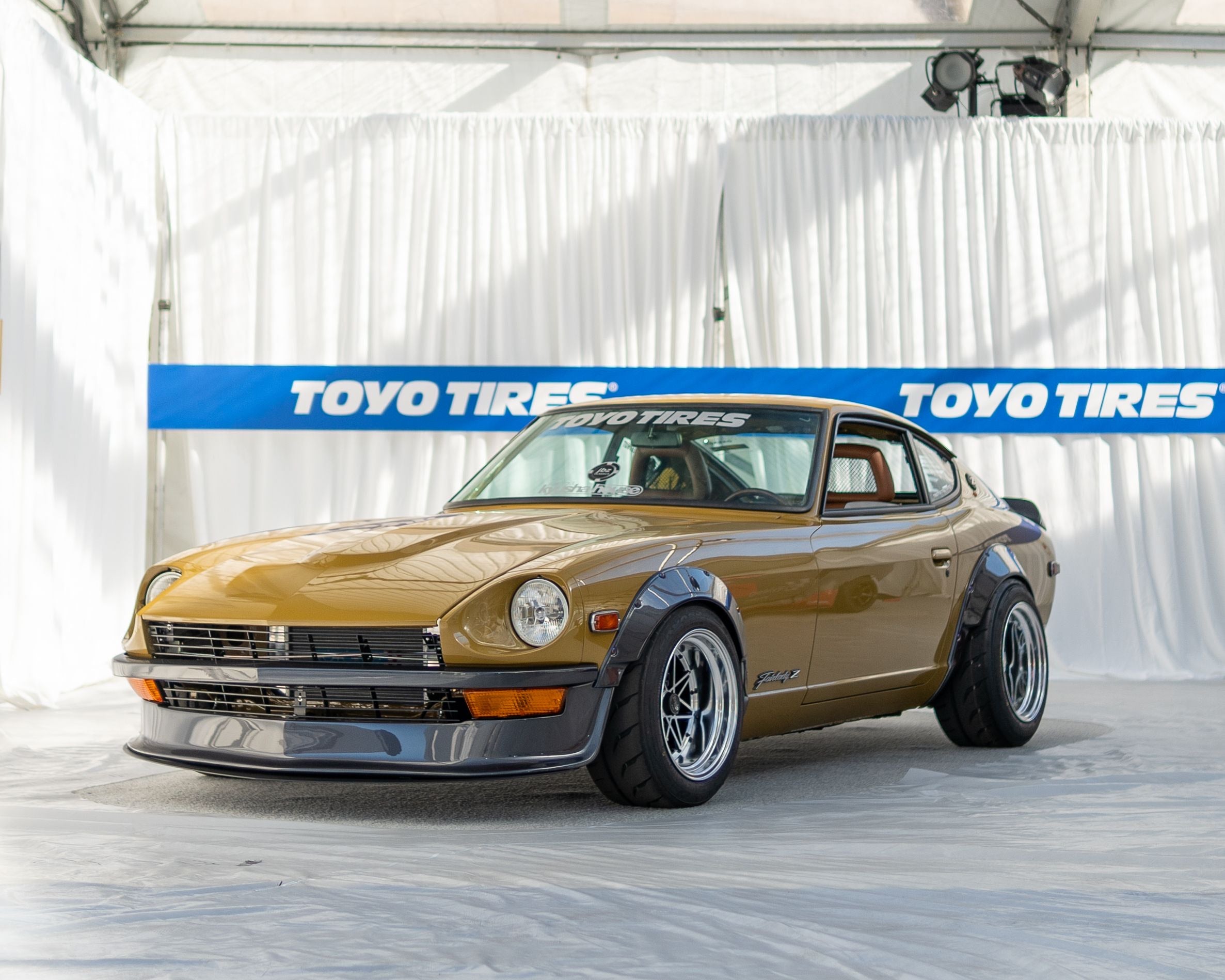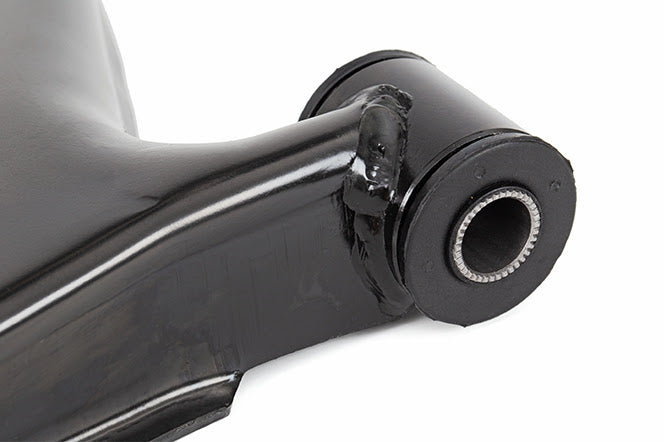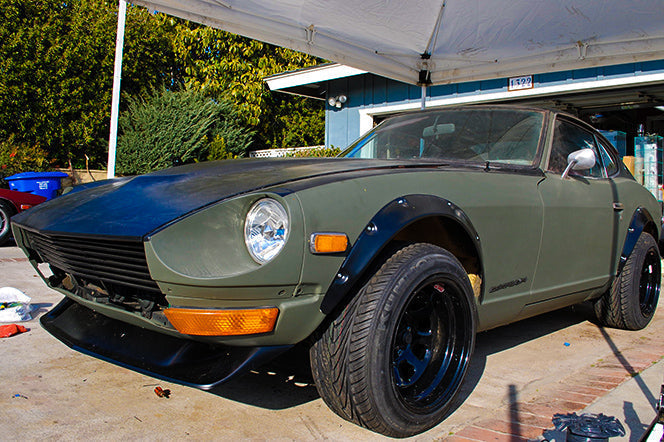Pay attention to the sounds your Datsun Z makes as you turn into a corner - they often reveal how healthy the suspension bushings are. The bushings sit between metal joints, soak up road vibration, and keep unwanted movement in check. When the rubber dries out or the polyurethane hardens, you begin to catch faint squeaks or knocks, and the car starts to feel a bit loose.
Fresh bushings keep the suspension in line, so your feedback stays consistent every time you carve through a bend.
Pick factory rubber for a gentle ride, choose polyurethane for a sharper response, or move up to spherical bearings if you want to track the car.
Swap the tired bushings for new ones, and you're likely to spot the change on the very first drive. The car tracks straighter, the steering feels steadier in your hands, and weekend runs suddenly bring back the excitement of that first day behind the wheel.
Let's talk about this together!
Table of Contents
How Are Rubber and Polyurethane Different?
Soft rubber helps to cushion bumps in the road, so your coffee stays in the cup and never reaches the dash. You feel that calm ride the moment you sit behind the wheel, and it keeps stress off your shoulders right through rush hour traffic. That small detail can save a shirt and a bit of cleaning up later.
That gentle feel suits daily commutes and weekend drives. Loose gravel or expansion joints pass under the tires, and the cabin stays quiet. Your passengers speak at a normal volume, your playlist sounds clear, and the trip feels relaxed from start to finish. You may even notice less fatigue at the end of a long day on the road.
Polyurethane goes for a different goal - crisp feedback. These tough mounts hold their shape under load, so the suspension moves just as the chassis expects. Turn the wheel, and the front end answers at once. Track-day drivers, autocross fans, and anyone who values very sharp control often lean toward this setup.
The cost shows up in ride harshness. More road noise slips into the cabin, and sharp edges in broken asphalt reach your seat. Plenty of Z owners accept that extra bite because the car now answers every input with precision. If you cover many highway miles, think about whether that extra edge lines up with your priorities.

Heat oil and time wear rubber sooner than poly. After several summers of heat and winters of salt, rubber can crack, dry out, or go soft. Gear oil or brake fluid speeds the decline even further. City dwellers who face stop-and-go traffic see the wear show up sooner still.
Poly shrugs off those same assaults. It resists chemicals, handles heat cycles, and keeps its firmness year after year. Swap to poly once the factory parts fade, and you may not open that area again for a very long while. I tend to check torque on nearby bolts at the same time, then forget about the mounts for years.
You feel the biggest change on a twisty back road. Fresh poly mounts let the Z lean less in hard corners and settle into the apex with confidence. The whole car stays planted and predictable, so you pick a line without any delay. Confidence builds with each corner, and you cast your eyes farther down the road.
Natural rubber leaves a bit more flex in that same curve, and that extra give can help the tires stay in touch over rippled pavement. Some racers still place rubber in spots where a hint of compliance serves them well. As always, the right mix comes down to how you plan to use the car.
Kit Options
Pick the right suspension bush kit as soon as you decide to upgrade. Your choice shapes ride feel, cabin noise, and later upkeep. That may look like a small choice, yet each pivot relies on those bush parts, so a slight change echoes through the entire chassis.
Factory-style rubber master kits cover every 240Z, 260Z, and 280Z. You get each piece from rack mounts to differential cushions, so fit stays uniform front to rear. The softer rubber smooths daily trips yet still copes with moderate corner load. Rubber tends to slot into place with basic hand tools, and replacement often wraps up in an afternoon. That old layout also eases inspection for track-day tech staff since it matches what they expect straight from the factory.
Drivers who want faster response often turn to polyurethane. Energy Suspension sells the Hyper-Flex System in several colors that let you add a bit of personality under the chassis. The firmer compound cuts unwanted flex and helps the car track straight through quick bends. You'll likely notice a faster wheel response the moment you merge onto a ramp. Because polyurethane resists oil swell, you can park above the occasional drip without worry.
That same Hyper-Flex set handles rough concrete without protest. You may feel sharper feedback at turn-in and steadier grip through the middle of a bend, while cabin comfort stays civilized.

Prothane's Total Bush Kit offers another solid polyurethane route. Its uniform hardness keeps torque forces under control, and the box arrives with a control arm, strut rod, bump stop, and transmission mounts. The single package gives the car one consistent feel from nose to tail. Do remember to coat each sleeve with the supplied silicone grease to stop squeaks before they appear. Every sleeve is already chamfered, so press work moves along without drama.
Many Z owners weigh a complete kit against a single-part swap. A single piece seems cheaper at first, yet the numbers flip once you add repeat alignments and extra workshop hours. Save yourself the hassle - fit one full kit and spend that spare time out on the road. Dealers often quote two separate sessions, one now and another after the next part fails, so your invoice balloons fast. On the road, a uniform kit can free you to push harder with less guesswork.
Mix rubber with polyurethane, and you tend to create uneven coil rates and patchy response. Stick with one material to keep road manners predictable and to build confidence every time you tip the wheel into a corner. A matched set also makes later diagnostics simpler because you rule out material mismatch right away.
Before you start, browse a few forum threads and vendor galleries. Clear photos lay out stubborn mount positions and keep confusion low. Some owners finish the entire swap over a long weekend, while others spread the task across several nights. Either way, the very first test loop will reward the effort. Set aside a sturdy vise, fresh blades, and a torch before you crawl under the car. Those extras speed removal when an old sleeve rusts to the arm. Mark bolt heads with chalk as you remove them, and that simple step trims minutes when you torque parts back in.
Cost always enters the chat. Polyurethane kits run a bit higher than basic rubber, yet they usually deliver crisper wheel response and a longer service span. Rubber still wins if you prize a quiet cabin and the smoothest ride. Decide where you sit on that scale, then choose the bundle that meets your own goals. Prices move a little from store to store, so browse online lists and call local suppliers for a quick quote.
Which Bushings Fit Each Suspension Point?
Start by pairing each bushing with its exact spot on your Datsun Z. The front control arms take their own style of bushing, sold in factory rubber or the firmer polyurethane sets you can pick up from Prothane and similar makers. Either choice shifts how the nose of the car reacts on the road. Even a small mismatch can sit unnoticed for months before it shows up as a pull or a clunk, so cross-check part numbers now, and you may save hours later. After that, move to the rear control arms. Each side uses two bushings, one forward and one aft. The forward piece runs a bit longer, so you cannot swap them without trouble. Pull every arm, set it on the bench, and see at a glance which bore accepts the longer sleeve. Many first-time owners mix them up and create play in the suspension.
Use the correct arm length to set alignment. Any change in length shifts the geometry and alters how the car feels when you push through a turn. You want planted cornering, so measure each sleeve before you press the shell into place. Slide a caliper across the sleeves if you need proof. Check the tension rod bushings as well. Many track drivers switch to ball and socket kits because they let the rod pivot yet still keep the chassis steady. If you spend time on rough streets or at local track days, that extra freedom up front lets the tires stay planted without the loose shimmy that comes from tired rubber. You'll notice the benefit the moment you leave the driveway.

Improve steering feel next. The rack bushings and the coupler sit between you and the wheels, so fresh parts tighten the response right away. After you swap them, the vague zone in the center almost disappears. Plenty of owners say the change feels much like a new rack for a fraction of the cost. Then, look at the sway bar bushings and the end links. These small parts hold the chassis flat in corners and usually end up last on the list. Add them to your order to round out the front suspension service. Because the bushings move through a full range every mile, fresh grease and the right preload help them last longer.
Now crawl under the car and look at the powertrain mounts. The differential and transmission bushings sit under constant load, soak up vibration, and keep the driveline straight. Treat them as wear items, not lifetime parts, and you'll keep the cabin free of unwanted rattles. The differential mount takes some of the hardest hits on the car, while the transmission crossmember carries real weight. Even though you seldom see these hidden parts, they deserve the same care that any control arm gets. Neglect here can send noise up through the floor pan, so plan the swap while the car is already apart.
When you order, match every sleeve, shell, and washer to its spot. The wrong inner sleeve can bind, squeak, or walk out after only a few drives. A quick check now may save a redo later. Lay each piece out on a tray in the order you plan to install it. That simple step makes the final assembly almost automatic. Set the car back on the ground, torque every fastener with the weight on the wheels, and enjoy the crisp feel you worked so hard to earn. Before the road test, set tire pressure and give the lugs a quick recheck.
Performance Alternatives
Go straight to steel bushings with spherical joints when you need precise control on the track. They hold every suspension arm tight, leave zero deflection, and relay each hint of road texture right through the wheel. Because nothing moves unless you ask it to, the steering feels extremely direct. Many drivers who chase razor-sharp input say they love the feedback. You do, however, trade away comfort. On ordinary streets, the ride feels harsh, road noise climbs, and vibration reaches the cabin in a heartbeat. Most weekend racers shrug off that penalty since tighter response often cuts a few seconds from every lap, and every fraction of a second can matter in timed sessions.
That balance between control and comfort usually feels obvious the first time you push the car hard. You sense every crack in the pavement, and a long trip may wear you out. If you want a softer path to sharper behavior, adjust the suspension geometry instead. Knuckle risers that slip between the steering arm and the strut take care of bump steer in most lowered Z cars. They sit almost hidden, yet they have a large effect on the arc of the front wheels. You can order them in either three-quarter or one-inch sizes, so matching the part to your current ride height stays pretty simple. Even this small tweak can fully change how the suspension moves as it compresses.
The reward shows up right away at autocross. Many Z owners report steadier corner entry, stronger mid-corner grip, and more predictable lap times once the parts sit in place. Instead of guessing how the front end might react, you feel a smooth, repeatable response every time you turn the wheel. The chassis stays planted, keeps the tire flat, and lets you lean into each bend with extra confidence.

Plan the whole job before you click buy. After any geometry change, set an appointment for an alignment that matches the new setup. That visit also gives the technician a chance to spot any odd tire wear or loose hardware. Skip that step, and you may lose the gains and end up with poorer handling.
Full polyurethane kits now cover every early Z model and sit right in the comfortable middle ground between soft rubber and hard metal. You gain quicker response without the need to endure the extreme harsh ride that comes with a complete spherical setup. For street use, the difference feels firm yet still civil. Stock-style rubber still suits anyone who values comfort and originality. If your Z spends most of its life on public roads, the factory ride remains a pleasant choice. Most suppliers even let you mix materials so you can stiffen the key points and leave the rest relaxed. That flexible approach can help you tailor the car to the way you actually use it instead of chasing a single, one-size solution.
Build Your Dream Car
Swap the worn bushes for fresh rubber or polyurethane units to tighten your classic Z at once. The ride firms up, steering gains clarity, and you finish the job in one afternoon. That single move usually gives more road feel for the money than any large upgrade. You'll notice it each time you roll out of the driveway.
Pick the material that suits your goals. Rubber keeps a smooth vintage character, while polyurethane sharpens response and can add a bit of extra road noise. Think about how you use the car during the week, balance comfort with control, and match the kit to that habit.
You can install a set at home if you enjoy hands-on projects. A solid jack, a simple press, and a free weekend usually cover the tools and time. Move slowly, add grease, and double-check torque to lock in success. When the final bolt seats, you'll feel quiet pride. Clearer feedback lets you place the car with confidence on a back road, yet the ride stays civil for a weekday commute. That change removes the vague float and builds trust in every quick lane change.

Skillard backs that vision. Our crew drives these cars, too, so we shape every part to blend style with real performance. We test each piece on our own Zs before we offer it to you because we want the fit to go smoothly and the results to last.
Choose from bumpers, aluminum door cards, center consoles, spoilers, and other accents to freshen the cabin or the exterior. Each component leaves the shop precisely trimmed for your Datsun, packed with the needed fasteners, and ready to bolt on.
Visit Skillard.com when you're ready to pick the parts that speak to you and turn your Z into a personal statement. The possibility already waits in the garage - we stand by to help you unlock it, one well-made component at a time!





